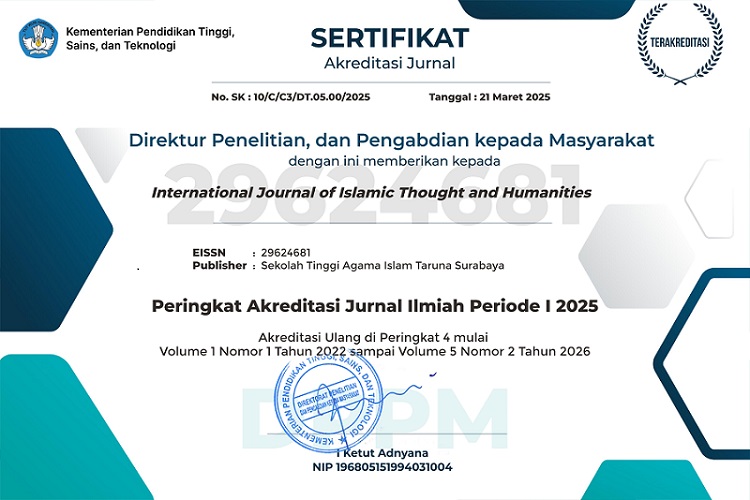Critical Study of Islamic Educational Language in the Naquib Al – Attas Perspective
DOI:
https://doi.org/10.54298/ijith.v3i2.286Keywords:
Naquib Al-Attas, Islamic Education, Educational LanguageAbstract
Linguistically, Islamic education has the equivalent of Arabic words in the form of tarbiyah, ta'lim, and ta'dib. After reviewing the meanings of the three languages, each of them has a characteristic that has consequences on different target fields. Tarbiyah is more directed to the physical- material aspect; ta'lim leads more to cognitive-intellectual aspects ; ta'dib is more directed towards moral-spiritual aspects. In the study of Naquib al-Attas, in fact the Arabic language which is more appropriate to be used as the equivalent of Islamic education is ta'dib, because ta'dib contains words that focus on the formation of a moral-affective domain, where it is the essence of the goals of Islamic education. However, the study of al-Attas was not automatically agreed upon by other Muslim scientists. Many of them are pro, but not a few contra. Ijtihad al-Attas about ta'dib, although it produced a monumental finding, tarbiyah is still popularly applied in pointing out the language of Islamic education.
Downloads
References
Abdurrahman al-Suyuti, J. (1984). Al-Jami’u al-Shaghir, trans. Najih (Surabaya: Bina Ilmu, 1985), 111. See also M. Athiyah al-Abrasy, al-Tarbiyah al-Islamiyah, terj. Bustami A. Ghani and Djohar Bahry. Bulan Bintang.
Al-Asfahani, A.-R. (1972). Mu’jam al-Mufradat Alfadz al-Quran, Tahqiq Nadim Mar’asyii. Dar al-Khatib al-’Arabi.
Al-Attas. (1986). The Dilemma of the Muslims, trans. Anwar Hadi Wasi and M. Mokhtar Zaini. Bina Ilmu.
al-Nadi al-Badri, M. (t.t.). Al-Naqd al-Adabi. Faculty of Adab IAIN.
Al-Nahlawi, A. (1989). Ushul al-Tarbiyah al-Islamiyah wa Asalibuha fi al-Bait wa al-Madrasah wa al-Mujtama’, terj. Heri Noor Ali. Diponegoro.
Athiyah al-Abrasy, M. (1986). Al-Tarbawiyah fi al-Quran, trans. Judi al-Falasany. Bina Ilmu.
Barnadib, I. (1986). Intelligence is the ability to know and see problems and solve them successfully. With intelligence, people are able to give something right and right. See Imam , Philosophy of Education. Andi Offset.
Departemen, R. I. (2009). Al-Qur’an dan Terjemahannya (1 ed.). PT Sygma Examedia.
Fadlil al-Jamaly, M. (1987). Al-Tarbiyah al-Islamiyah, terj. Bustami A. Gani and Johar Bahri. Bulan Bintang.
Fatah Jalal, A. (1988). Min al-Ushul al-Tarbawiyah fi al-Islam, occurred. Noor Ali. Diponegoro.
Idris, Z. (1984). Education Basics. Aksara.
Ilmiyati. (1998). Philosophy of Islamic Education: Study of the Thought of Naquib al-Attas. IAIN Su-Ka.
Madjid, I. (1989). Concept of Family Education in the Koran. Postgraduate IAIN Su-Ka.
Madjid, N. (1987). “The al-Attas argument is difficult to maintain”, in Panji Society, No. 531.
Mandzur, I. (t.t.). Lisan al-Arab (Cairo: Al-Dar al-Misriyyah li al-Ta’lim wa al-Tarjamah, tt.).
Naquib al-Attas, S. M. (1987). Concept of Education in Islam, trans. Haidar Bagir. Mizan.
Nashih Ulwan, A. (1988). Tarbiyah al-Awlad fi al-Islam, trans. Saiful Kamalie and Noor Ali. As-Syifa.
Nasution, F. (1991). Tarbiyah, Ta’lim, or Ta’dib", in Panji Society, No. 705.
Omar Mohammad, al-T. al-Syaibany. (1979). Falsafah al-Tarbiyah al-Islamiyah, trans. Hasan Langgulung. Bulan Bintang.
Organizing, T. F. (1982). Translators of the Koran, Al-Quran and their Translation. RI Ministry of Religion.
Poerwadarminta, W. J. S. (1982). General Dictionary of Indonesian Language. Balai Pustaka.
Qutb, S. (1971). Fi Zilal al-Quran. Dar Ihya al-Turats al-Arabi.
Rais, A. (t.t.). Cakrawala Islam: Between Cita and Facts . Mizan.
Steingass, S. F. (1978). Arabic-English Dictionary. Cosmo Publication.
Wehr, H. (1980). Dictionary of Modern Written Arabic–English, Edited by J. Milton Cowan. Librarie Du Liban.
Downloads
Published
How to Cite
Issue
Section
License
Copyright (c) 2024 Nasiri, Afifah

This work is licensed under a Creative Commons Attribution-ShareAlike 4.0 International License.
Authors who publish with this journal agree to the following terms:
- Authors retain copyright and grant the journal right of first publication with the work simultaneously licensed under a Creative Commons Attribution-ShareAlike 4.0 that allows others to share the work with an acknowledgement of the work's authorship and initial publication in this journal.
- Authors are able to enter into separate, additional contractual arrangements for the non-exclusive distribution of the journal's published version of the work (e.g., post it to an institutional repository or publish it in a book), with an acknowledgement of its initial publication in this journal.
- Authors are permitted and encouraged to post their work online (e.g., in institutional repositories or on their website) prior to and during the submission process, as it can lead to productive exchanges, as well as earlier and greater citation of published work (See The Effect of Open Access).


















